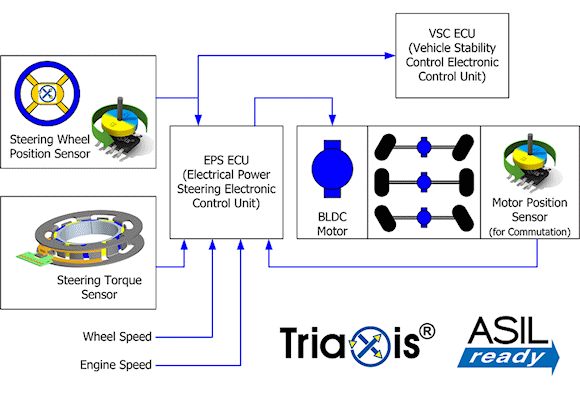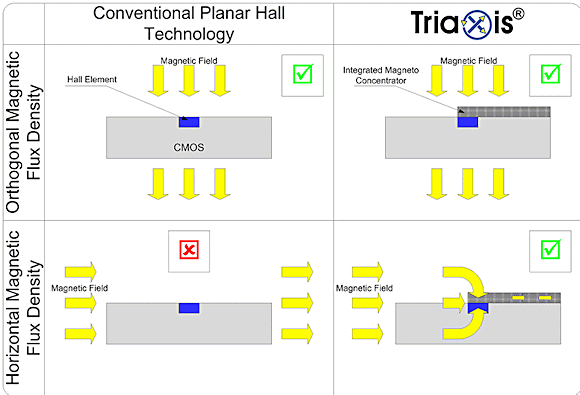
With the level of complexity in modern automobile electronic systems escalating, increasing use of sensor technology to allow interaction between the external analog environment and the vehicle's digital circuitry is bringing huge benefits in terms of driver/passenger comfort and safety. With each new generation of car model, we are seeing a major upswing in the number of magnetic field sensor devices included in the design. As the scope of tasks they can perform continues to expand, these sensors are becoming viable for use in everything from headlight positioning to air conditioning, and from electronic stability control to anti-lock braking systems.
Application
A key application for magnetic sensors is in electric power steering (EPS) systems. Figure 1 describes the basic structure of such a system. Here magnetic sensor devices provide the necessary information for controlling the mechanical torque boost, which assists the driver with steering while the vehicle is travelling at low speeds or during parking procedures.

Fig. 1: Typical EPS system with three discrete sensors providing data to the ECU
Engineers can use the Hall Effect to detect a magnetic field and determine its strength (B). This phenomenon describes the interaction between magnetic fields and the current flow in a material. An accumulation of electrical charge resulting from this interaction creates a measurable voltage directly proportional to the size of the applied magnetic field.
Generally speaking, an EPS system consists of three different sensors:
- The steering wheel position sensor, which derives the absolute position of the steering wheel.
- The steering torque sensor, which converts torque applied to the steering wheel by the driver into an electrical signal for processing.
- The motor position sensor, which controls the commutation of a brushless DC motor employed in the system.
All data acquired using these sensors transfer to the electronic control unit (ECU) at the heart of the EPS system for processing. This unit also obtains information from other sources that relate to metrics such as the vehicle's speed, RPM, etc.
There are drawbacks with utilizing conventional planar Hall Effect sensors in automobiles' EPS systems, as they are basically only able to detect a magnetic field perpendicular to their surface. This means that systems relying on this sensor technology will require multiple sensing devices all positioned so that they are perpendicular with one another. Not only does this push up the cost, but also commands more valuable board space for this activity.
Multi-Directional Magnetic Sensing Devices
A variety of different multi-dimensional sensing solutions have entered this market in recent years. The Hall-based solutions mainly utilize the emerging, but still not fully mature Vertical Hall technology. Though it exploits the same physical principles, integration of Vertical Hall technology is still at an early phase compared to sensors employing the long-established Planar Hall technology.
Melexis has taken a different approach, which is making use of its own patented technology to develop a series of highly advanced multi-directional Hall Effect sensor products. These offer a compelling mixture of high performance, compact form factor, resilience to harsh operational conditions through robust packaging, low unit cost, and easy implementation. Its Triaxis series can help engineers to overcome the difficulties that having to deal with deployment of several separate sensors will cause.
Shown in Figure 2, each Triaxis device has two pairs of orthogonal sensing elements running in both directions along the surface of a highly integrated mixed signal CMOS IC. The unique Integrated Magnetic Concentrator (IMC) ferromagnetic film deposited onto the chip enables shaping and enhancing the magnetic field around the IC, thereby increasing sensitivity levels and improving signal-to-noise (SNR) characteristics.

Fig. 2: Melexis Triaxis Hall Effect Sensor with Orthogonal Sensing Elements & IMCTM Film
This along with purpose-built algorithms make it is possible for the different magnetic field components found in a horizontal orientation to the sensor IC (i.e. ones with BX and BY components to take into account), in addition to the field component vertical to it (BZ) to be determined with a high degree of accuracy.
This technology enables greater consistency between the accuracy of the magnetic field components signals generated by the BX, BY BZ sensing elements. Each of the three differential voltages acquired by the sensor then passes through the device's integrated analog-to-digital converter (ADC). After this data conversion step, on-chip digital signal processing commences to give a precise absolute position measurement.
This approach presents the automotive industry with a more elegant and easy to execute methodology by which to undertake magnetic field sensing. Furthermore it has clear operational advantages over alternative multi-directional solutions currently on the market which rely on highly complex mathematical theory and sensor technology that does not yet have the proven reliability of conventional CMOS Hall Effect sensors. It furnishes the EPS system's ECU with high quality data on rotational or three-dimensional displacement with ±1° accuracy on a 360° rotation.
Conclusion
Multi-directional Hall Effect sensing is now leading to automobile EPS systems that have greater operational effectiveness. Implementation of more sophisticated sensor devices with multiple sensing elements on a single die will enable fast and accurate acquisition of information required by the EPS system. Through this the precise position of the automobile's steering wheel can be ascertained and the performance of its EPS system improved while keeping the costs involved and space required for implementation to a minimum.
About the Author
Based in New England, Peter Riendeau is Marketing Communications Manager at Melexis. With over twenty years of semiconductor industry experience, particularly within the field of sensor technology, Peter has held high-level positions in both engineering and product marketing. Prior to joining Melexis, he worked for Cherry Electrical Products, Concord Sensors, and Allegro Microsystems. Peter studied Electrical Engineering at the New Hampshire Technical Institute.